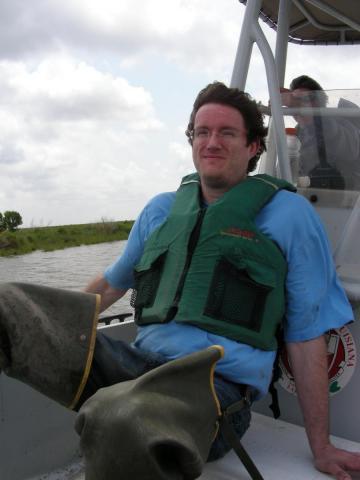What makes tick-born pathogens tick?
(UL Lafayette news item: Tue, 12/05/2017)

The battle against pesky ticks during what could already be considered the unbearable Louisiana heat rages on in a new research study. Dr. Scott Duke-Sylvester, an associate professor of biology at the University of Louisiana at Lafayette, has joined a team of researchers to analyze how transmitted diseases born from pathogens - microorganisms that cause illnesses - found in the small arachnids will affect human health. "We are hoping to have a better understanding of where the disease is distributed in different parts of the country, if there's any change in that distribution and which tick species are responsible," he said.
Duke-Sylvester was recently awarded a grant of $248,000 through the National Institutes of Health to participate in the collection of tick samples from around the state and the analysis of the results over the span of five years. The award comes as a portion of a $2.5 million grant presented to the four universities involved in the project titled, "Eco-Epidemiology of Tick-Borne Rickettsial Pathogens." Those universities include the project's principal investigator, Old Dominion University in Norfolk, Va.; the University of Florida, located in Gainesville; and the University of KwaZulu-Natal, situated in Durban, South Africa.
Rickettsial pathogens can be linked to illnesses like Lyme disease, typhus and spotted fever and are known to cause symptoms like joint and muscle pain. Typically, adolescent ticks parasitize small animals, like squirrels and birds, while adults will turn towards larger animals like deer. Duke-Sylvester and the other researchers are collecting samples from across the country and studying the patterns in which these ticks will follow and if any factors will cause them to deviate. One simple method of gathering samples is through flagging. Flagging requires a rope that's attached to a piece of cloth made of either wool or felt to be dragged through the grass, seizing ticks in the process. Large nets will also be placed in forested areas to capture birds who are also likely to be carrying. Every half an hour, the team will survey the netted areas. Duke-Sylvester will use these approaches over various parts of the state from May to August (of 2017) - the most infested months.
"With the climate changing and everywhere is getting warmer, we've already seen some movement northward," he explained, "and we would like to document that more precisely to be able to make predictions because as the disease spreads, the potential for more human infections increases." In addition to the research, the professor plans to use a portion of the grant to hire two or three student workers who may be interested in the field work. Any undergraduate or graduate student interested in the project should contact Duke-Sylvester directly and provide him with a short curriculum vitae.
(Photo credit: Department of Biology)
